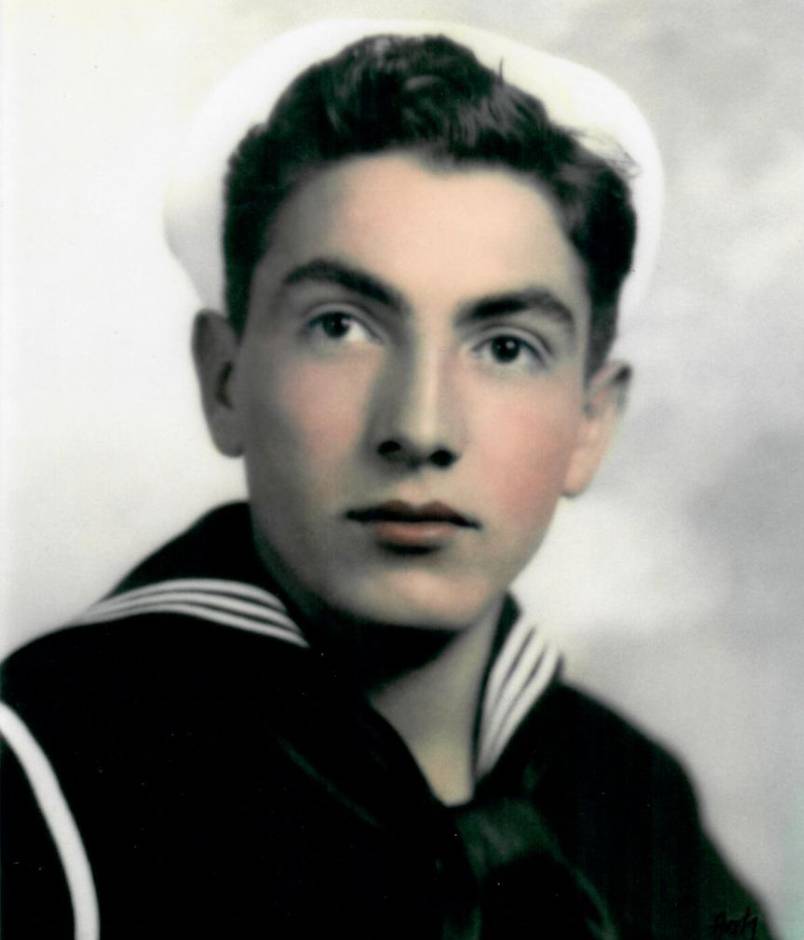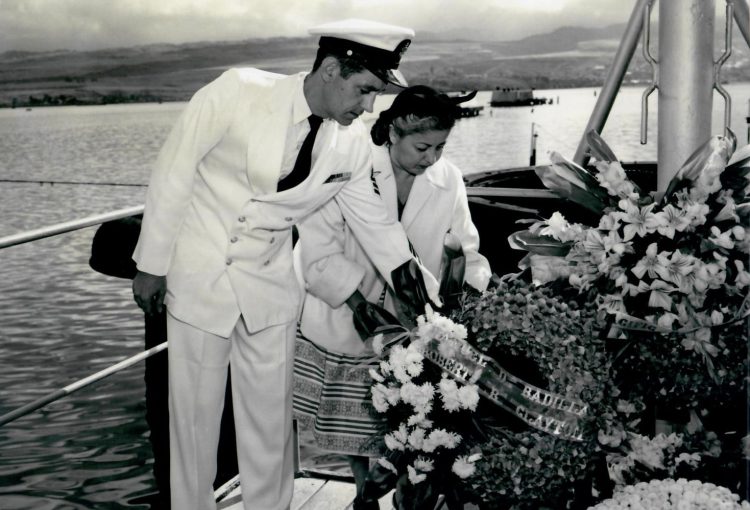
- Rank: F1c
- Branch: US Navy
- Home Town: Santa Barbara, CA
- Date Of Birth: May 16, 1921
- Disposition: Unrecovered
- Family DNA on File:OnTheWay
F1c Manuel Dominic Badilla
Manuel Dominic Badilla was born May 16, 1921, in Santa Barbara, California, to Manuel Badilla, a truck driver, and Soladad Cush Badilla. The father died in 1930 in Santa Barbara, though by then the parents had separated and Manuel was living in Long Beach, where his mother was a machine operator at a cannery. He dropped out of high school to work and help support the family, which included his younger sister, Margareta.
Manuel wanted to join the Navy, but for a long time his mother refused to sign the enlistment paper. She felt guilt for the rest of her days — she lived until 1975 — that she eventually relented. Mr. Badilla was a fireman first class when he was killed. For fun, he boxed for the Arizona team that competed against sailors from other ships.
Fifty years after her brother’s death, Margareta recalled that as kids they loved to go to the movies on weekend afternoons. But sometimes they would drop their movie money off a pier to watch the ocean currents cover the coins with sand. “Then we’d go home broke,” she said.

(Pictured above:) When Margareta visited the site of the Arizona on Dec. 7, 1958, she placed a wreath for her brother and his friend Bob Clayton.
The Japanese attack on Pearl Harbor killed 2,335 American military personnel. But the number doesn’t describe the hundreds of connections among the men who died on Dec. 7, 1941. These are four of the sailors linked by blood and friendship:
Robert “Bob” Roland Clayton died on the U.S.S. Arizona, as did Manuel Dominic Badilla, the classmate who became his best friend when Mr. Clayton moved to California in 1937. They were on the track team at Polytechnic High in Long Beach. Mr. Clayton graduated in 1938, while Mr. Badilla apparently dropped out in his senior year, 1939.
They enlisted in the Navy together on Oct. 10, 1939, and went aboard the Arizona five days before Christmas. Their plan was to run a commercial fishing business after their Navy days.
A week before he was killed, Bob wrote home. “I wish Japan would either fight or keep still. It’s on account of them that we’re out here.”
Until he’d moved to California Mr. Clayton’s best friend had been his cousin, Gerald. Their fathers were brothers, and the boys — who were the same age — grew up on farms near Central City, Nebraska.
They played football and basketball at Central City High, from which Gerald — known as Jerry — graduated in 1938.
In a typed, undated letter from Long Beach (probably in early 1938), Bob wrote to Jerry: “You say you might join the Navy, well my fran I have the same thots. Only I am going to wait bout a year and look the situation over in the line of employment and if nothing is doing I’m going to join the Navy.”
Bob also asked how Jerry was getting along in school and about his relationship with a girlfriend. “You know my fran you would really go for some of the dances they do out here,” Bob wrote. “Are they ever rugged, when a dame gets through dancing she’s laid up for the week.” He said his first semester in California was fine, “but I’m sure having a tough time” in typing class.
He also mentioned the ships he’d recently seen at Long Beach harbor. “Boy! it was really a keen sight. There was about 100 ships plus submarines, airplanes, etc.”
Jerry enlisted in the Navy on March 8, 1939, and went aboard the U.S.S. Oklahoma in June.
The cousins were happy that both of the battleships on which they served were based at Pearl Harbor because it meant they could see one another now and again on shore leave. But Dec. 7, 1941, ended all of that.
On Christmas Day the Central City Republican, the newspaper in the Nebraska town of 2,500, reported that Bob and Jerry were missing in action.
Then, in early January, Jerry’s family received good news: He was alive. “Several local men battled thru snow drifts” to deliver the message to his parents, the Republican said.
Within a couple of weeks the military confirmed Bob’s death, but the government continued to maintain that Jerry was alive. Finally, about the first of April, the secretary of the Navy sent this message to his parents: “Owing to the time which has now elapsed without word from your son, Gerald Lee Clayton, or report of his having been taken aboard any other Naval vessel or activity, the possibility of his being alive has been entirely abandoned…”
The bodies of most of the 1,177 men killed on the Arizona were never recovered — those of Bob Clayton and Manuel Padilla among them. Of the 429 men killed on the Oklahoma, remains of nearly 400 — including Jerry Clayton — were unidentified and buried in Honolulu. Seventy-six years later, thanks to new DNA technology, Jerry Clayton was identified. He was buried in July 2019 at Central City Cemetery in a ceremony attended by more than 50 relatives.
Pearl Harbor, however, did not end the tragedy of war for the Clayton family.
Bob’s older brother, Sam, a Navy aviation machinist’s mate first class, went missing in a crash off the coast of France on March 31, 1944. He was presumed dead in 1945 and awarded the Navy Air Medal. He is honored at the Cambridge American Cemetery in England at its monument to the missing. He enlisted in 1935.
More about Bob Clayton: He was born May 10, 1920, to Ray Clayton and Margaret Schudel Clayton. The family moved to Long Beach so the father could build oil rigs. His brother Richard joined the Navy after high school and served from 1944-1946. Bob was a coxswain third class when he died.
More about Jerry Clayton: He was born Jan. 30, 1920, to Lee Clayton and Grace Wagoner Clayton. His brother Kenneth enlisted in the Navy in 1942, and served in the Pacific, including on a minesweeper. He survived the war. Jerry was a storekeeper second class when he died.
One final sailor connects to this small circle of men at Pearl Harbor on Dec. 7, 1941.
Mr. Badilla’s uncle, Gregory Jankowiak, was on the U.S.S. Helena. He had no children of his own and called Manuel and Margareta his kids. He and Manuel spent the evening before the attack at a concert and planned to attend Mass together on the Arizona on Sunday morning.
Mr. Jankowiak was on a motor launch headed toward the battleship when Japanese bombs started to fall. The launch returned to the Helena, which was torpedoed in the first wave of attacks. But it did not sink because the crew shut hatches and doors to control flooding. Other sailors manned the light cruiser’s anti-craft guns and downed at least six Japanese planes. Thirty-one Helena men died, but Mr. Jankowiak, a chief petty officer, survived both the attack and the war.
Sources: Special thanks to Sheri Clayton Spomer and to Hal Fowler for sharing family letters and photos. The photo of Mr. Badilla’s sister, Margareta, shows her and her husband, James Berry, placing a wreath in memory of Manuel and his best friend, Robert Clayton, on May 30, 1959, at Pearl Harbor. Other sources include: the Central City (Nebraska) Republican; the Lincoln (Nebraska) Journal Star; Kearneyhub.com of Kearney, Nebraska; Long Beach (California) Independent; San Pedro (California) News-Pilot; the Grand Island (Nebraska) Independent; Census; Navy muster rolls; Cambridge (England) American Cemetery; California birth, death and marriage certificates; Long Beach (California) Polytechnic High yearbook; Central City (Nebraska) High yearbook; Coleman Mortuary of Hoquiam, Washington; U.S. Department of Veterans Affairs death files; grave markers; At’Em Arizona newsletter of Nov. 9, 1940. This profile was researched and written on behalf of the U.S.S. Arizona Mall Memorial at the University of Arizona.
